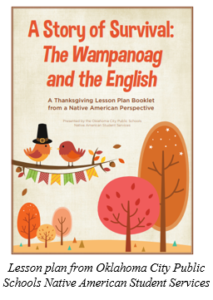Bringing Indigenous Perspectives to Thanksgiving Day Lesson Plans
By Aaron Leo & Kristen C. Wilcox
As the Thanksgiving holiday approaches, educators across the United States have the opportunity to explore Native American history with their students. Unfortunately, simplistic tales about the relationships of Native Americans and colonists still abound in children’s books and in other instructional resources which narrow children’s and young people’s understandings of the histories and contributions of Native American people. In this blog we highlight a few lessons from NYKids research about how educators can value Native American traditions and beliefs in schools and point to a few instructional resources that highlight indigenous perspectives and contributions.
“Not at the Expense of Their Culture”: Prior NYKids Study Findings
 In a prior study, Director of NYKids Kristen C. Wilcox found that a school that refocused attention on Native youth and family values, beliefs, and community norms saw exceptional growth in student persistence and eventual graduation. They did not sacrifice Native cultural norms to do this, but rather adapted to them and built from them a stronger bond between children and their teachers and between the curriculum and their lives.
In a prior study, Director of NYKids Kristen C. Wilcox found that a school that refocused attention on Native youth and family values, beliefs, and community norms saw exceptional growth in student persistence and eventual graduation. They did not sacrifice Native cultural norms to do this, but rather adapted to them and built from them a stronger bond between children and their teachers and between the curriculum and their lives.
Thanksgiving in the Curriculum
Unlike the example of the “Quill Valley” school in NYKids prior study, where Native American students’ and families input was sought in the development and implementation of the curriculum, in most schools, when it comes to things related to Native Americans, history teachers typically bear the greatest responsibility.
While history teachers hold a primary responsibility, other teachers also have opportunities for representing the past in ways that engage young people in thinking critically about Eurocentric narratives of historical events.
 Curricular choices, according to educator and scholar Michael Apple, inevitably are based on values and beliefs and when critically examined can offer opportunities to explore different and sometimes contradictory narratives.
Curricular choices, according to educator and scholar Michael Apple, inevitably are based on values and beliefs and when critically examined can offer opportunities to explore different and sometimes contradictory narratives.
As a progressive alternative, educators may seek to understand historical events from varied perspectives such as teaching the Civil War through the eyes of enslaved Africans or Thanksgiving from the vantage point of Native Americans whose perspectives and experiences of the holiday may differ greatly from the perspectives of descendants of Europeans.
Because any understanding of history deeply informs both present and future actions and beliefs, it can be argued that it is crucial that indigenous perspectives on the Thanksgiving holiday be included in lesson plans.
These plans benefit indigenous students but also provide a powerful example for all learners of how history can be viewed from various perspectives.
Bringing Indigenous Voices and Perspectives to Thanksgiving
Indigenous scholars and educators have developed a wealth of resources to aid teachers seeking to provide their students with indigenous perspectives on Thanksgiving.
The Museum of the American Indian, for instance, has created a range of lesson plans for teachers of various age groups. One such plan for younger students focuses on the ways in which interactions between Native Americans and colonists affected the food sources of Native people and asks students to examine the ways in which traditional diets of indigenous peoples were altered by the arrival of European colonists.
 Another example of a lesson plan which brings indigenous perspectives to Thanksgiving lessons is provided by Teaching Tolerance. In this lesson plan, educators invite their students to read short essays written by indigenous youth who describe their own views of the holiday. Students are then asked to reflect on how these perspectives may differ from their own experiences of Thanksgiving.
Another example of a lesson plan which brings indigenous perspectives to Thanksgiving lessons is provided by Teaching Tolerance. In this lesson plan, educators invite their students to read short essays written by indigenous youth who describe their own views of the holiday. Students are then asked to reflect on how these perspectives may differ from their own experiences of Thanksgiving.
A final example is drawn from the Oklahoma City Public Schools Native American Student Services. In a lesson plan packet entitled, “A Story of Survival: the Wampanoag and the English” created by indigenous teachers, students are given characteristics about both groups before and after contact. Special attention is given to dispel myths and stereotypes about Native Americans and the European colonists and engage younger students in activities based on cultural information and folklore.
Conclusion
For more on this topic check out NYKids’ related article and we wish you and yours a happy and healthy holiday.
